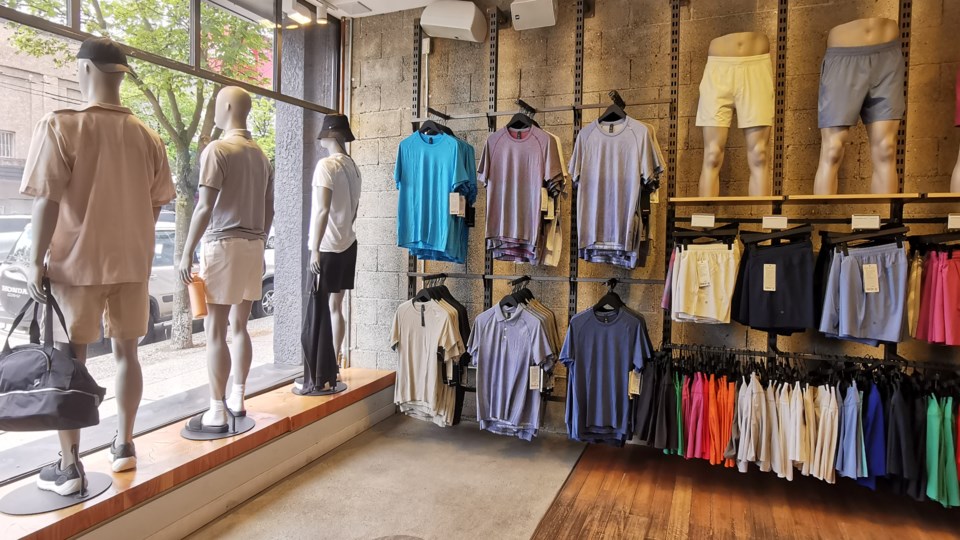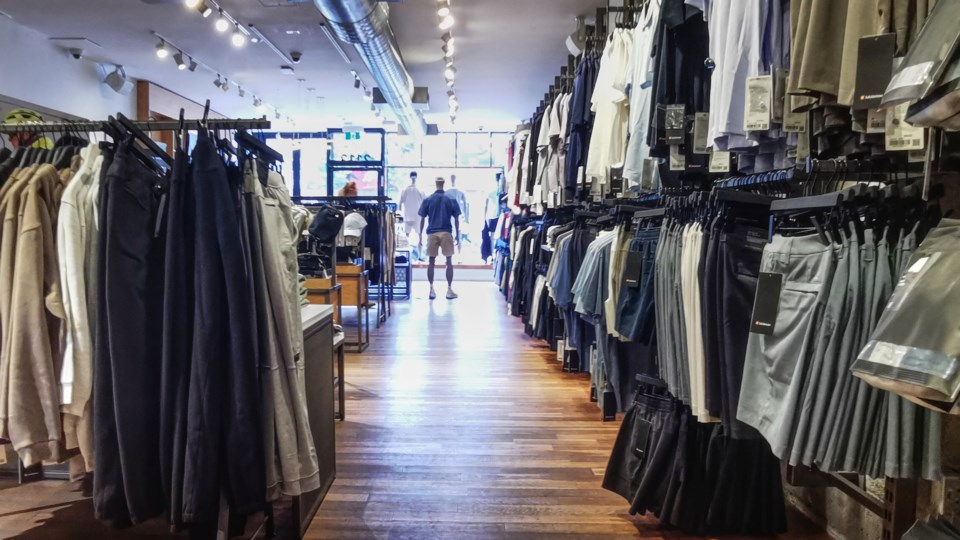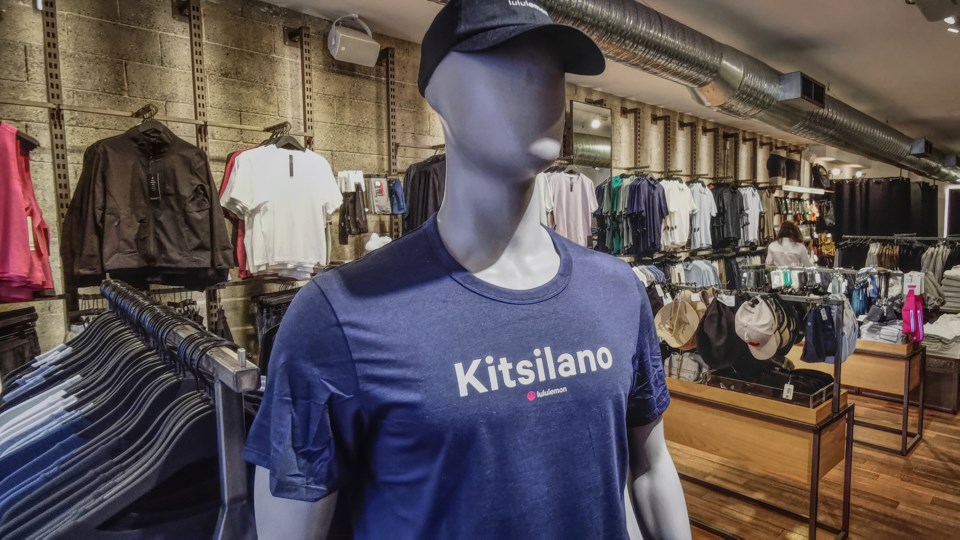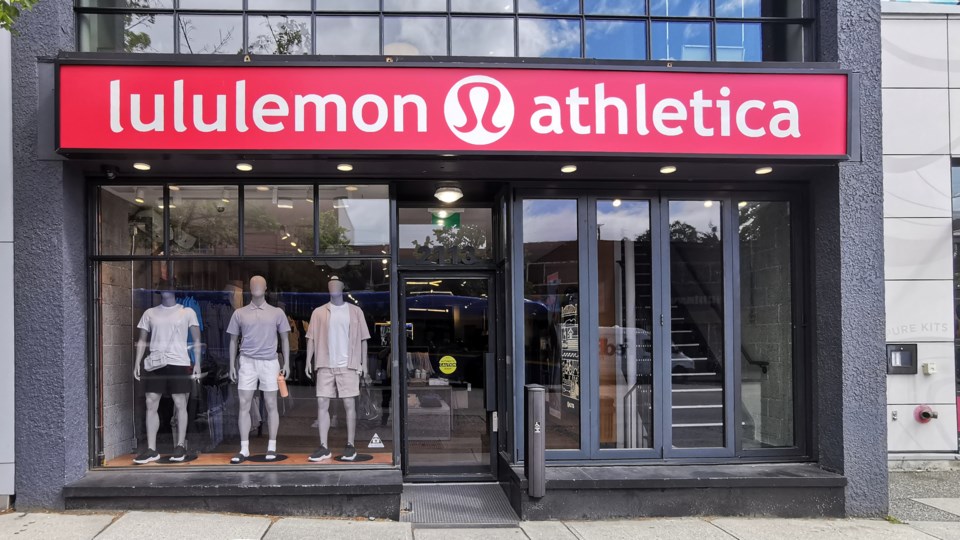One of B.C.’s largest homegrown retailers, Lululemon Athletica Inc. (Nasdaq:LULU), saw its sales, profit and share price soar during the COVID-19 pandemic.
The company’s operational growth has since slowed, raising concerns that more subdued performance could become the retailer’s new normal.
After Lululemon shares hit an all-time-high closing price of US$511.29 on Dec. 29—the last trading day of 2023—the company’s share price plunged despite stock markets having a banner year. By June 5, ahead of the company’s first-quarter earnings release, Lululemon’s share price had fallen 39.7 per cent from that 2023 closing high, to US$308.27.
Founder Chip Wilson still owns a large stake in the company, but that has not kept him from criticizing the athleisure giant for trying to chase higher profit margins and embarking on what he said was a “slow march to becoming The Gap (NYSE:GPS), with cheap acrylic sweaters,” according to a March LinkedIn post.
Another contributing factor to the company’s share-price decline was its May 22 announcement that its well-regarded, longtime chief product officer, Sun Choe, was leaving the company. Shares fell as much as seven per cent that day.
VF Corp. (NYSE:VFC) two weeks later announced that it had hired Choe to become global brand president at its Vans division in late July. VF Corp.’s share price rose 10 per cent following that news, again underscoring Choe’s influence and esteem in the fashion world.
Instead of replacing Choe, Lululemon said it will have a team of leaders with new roles.

Multiple reasons for slowing sales growth
Lululemon’s first-quarter sales increased 10 per cent year-over-year, to US$2.2 billion. That was in line with what stock market analysts had expected.
The company kept its sales outlook for the year unchanged, at between 11 and 12 per cent growth, year over year, which would put sales between US$10.7 billion and US$10.8 billion.
“That’s still really good,” Retail Insider Media owner and retail analyst Craig Patterson told BIV.
The problem is that Lululemon was coming off of two consecutive years where annual sales growth topped 20 per cent.
Customers returning to work in offices, and consumer frugality due to higher interest rates and inflation, may be part of the reason for the slowdown, Wedbush analyst Tom Nikic told BIV.
He added that the law of large numbers also plays a role.
“This is a business that did a little under US$4 billion in revenue in 2019 and they did US$9.6 billion in revenue last year,” he said.
“For a single apparel brand, there are not many that are bigger than Lululemon and growing faster. Nike (NYSE:NKE) is not growing this fast. Adidas (ETG:ADS) is not growing this fast.”
Operational mistakes have not helped, he added.
Lululemon warned the market in March that mistakes were made with its spring fashion line. The clothing was largely black, white and tan, and lacked colours that consumers wanted to buy, Nikic explained.
“Lululemon is never going to be the kind of brand that has a lot of super-bright, in-your-face products, but [the assortment] really was just too muted,” he said.
Lululemon’s other inventory problem was that it lacked sufficient clothing in smaller sizes.
Nikic chalked that up to the company’s customer base shifting younger, and youth tending to be smaller than the average Lululemon customer of previous years.
He said the company has a history of being able to turn around operational mistakes.
It faced a similar challenge of insufficient inventory in the first quarter of 2018 and was able to weather that storm, he said. Conversely, it had too much inventory in 2022, and was also able to soon get back on track, said Nikic.

International expansion seen as opportunity
Lululemon’s sales slowdown is particularly acute in what the company calls “the Americas,” even though that only includes the U.S. and Canada. This is where the company generates 73 per cent of its revenue.
The company’s sales increase in the U.S. and Canada was a comparatively paltry three per cent, or four per cent on a constant-dollar basis, to US$1.6 billion, in the quarter that ended April 28.
In the same quarter one year ago, year-over-year revenue growth in the U.S. and Canada was nearly 18.5 per cent.
The saving grace for Lululemon is that its international sales growth has been spectacular, and that helped raise overall sales growth in the most recent quarter.
In its hottest market—mainland China—sales rose 45 per cent on a reported basis and 52 per cent on a constant-currency basis to US$210.1 million. But even that was slower growth than what was seen in recent quarters: Lululemon saw 67-per-cent year-over-year revenue growth in mainland China in the fiscal year that ended in January.
CEO Calvin McDonald cited Asia as his company’s biggest growth opportunity when he was hired in 2018.
“We have a real big opportunity internationally, in particular in Asia,” he said weeks after he joined the company. Six years later, Lululemon doesn’t appear to have established itself more fully in the region.
In the company’s first quarter, about 14 per cent of Lululemon’s revenue came from mainland China, up from 10 per cent in the same quarter one year earlier.
“The thing with China is it’s a very challenging market to operate in,” Nikic said. “Obviously, it’s a big market, but navigating the local can be a challenge. Every city is like a different ecosystem, and finding the right real estate can be difficult.”
The COVID-19 pandemic no doubt slowed progress in opening new stores.
Lululemon first expanded beyond Canada and the U.S. by opening franchised stores in Australia in 2004 and Japan in 2005. The stores struggled. Lululemon bought out its franchisees and closed most overseas locations in 2008.
It now operates in 25 countries around the world but is relatively unknown in most.
“Our unaided brand awareness remains low in every country where we operate, except our home market of Canada,” McDonald told analysts on a June 5 conference call, hinting that this low brand recognition was an opportunity.
The company had 711 stores on April 28, which was the same as three months earlier.
More than half, or 369, are in the U.S., while 127 are in China. Canada, where the company rose to prominence in the 1990s and 2000s, boasts the third-greatest number of stores at 71.
CFO Meghan Frank said on the company’s conference call earlier this month that Lululemon plans to open a net total of 35 to 40 new stores this fiscal year, with five to 10 of them in the Americas.
The rest are slated to be in international markets, “primarily” mainland China, she said.

Competition nips at Lululemon’s heels
On the call, McDonald dismissed suggestions that his company was vulnerable to upstart competitors.
“Competition in our space has always been there and been intense and we’ve always been able to continue to perform and compete,” he said.
Patterson is not as sure.
“Lululemon’s main competitor right now is Alo Yoga,” he said. “[The Gap-owned] Athleta is one of them to a degree, but it’s a lower price point and it’s probably a different quality level.”
Vuori is another fast-growing apparel chain with a similar price-point to Lululemon, and it is seen by many as a competitor, but Patterson said he thinks Alo Yoga is the real threat.
That Beverly Hills, California-based company opened its first store in Canada in September 2022 and Patterson said he is confident that it will have 15 stores across the country by mid-2025.
“The fifth location in the Greater Toronto Area is under construction and the company is penetrating every single major market in Canada right now, with at least two stores,” he said.
Alo Yoga operates a store at CF Pacific Centre in Vancouver and Patterson said he expects the company to open stores in Burnaby, at Metropolis at Metrotown, and at Vancouver’s Oakridge Park, when that development reopens, likely next spring.
Nikic acknowledged the rise of competitors but said he believes Lululemon has benefits from being the sector’s behemoth. He is also maintaining the “outperform” rating that he has given Lululemon’s shares since he started covering the company two years ago.
“Alo [Yoga] and Vuori seem to be doing very, very well,” said Nikic, who is based in New York. “Just walking around New York you just see people in those two brands a lot more than you used to.”
Alo Yoga and Vuori remain much smaller. He estimated Vuori’s overall store count at about 50, versus 80 to 90 for Alo Yoga. That compares with 440 North American stores for Lululemon.
Lululemon bullish on its own future
Lululemon’s share price popped 4.8 per cent the day after its June 5 earnings report, likely in part because the company raised its profit outlook for the fiscal year that ends in January.
Lululemon now estimates its earnings per share to be between US$14.27 and US$14.47 this fiscal year. That is up from previous guidance of between US$14 and US$14.20.
The company generated US$321.4 million in net profit in the quarter that ended in April. That was up nearly 10.7 per cent, compared with US$290.4 million in the same quarter one year earlier.
The company also showed confidence in its own operations by increasing its stock buyback program, by US$1 billion, to US$1.7 billion.






